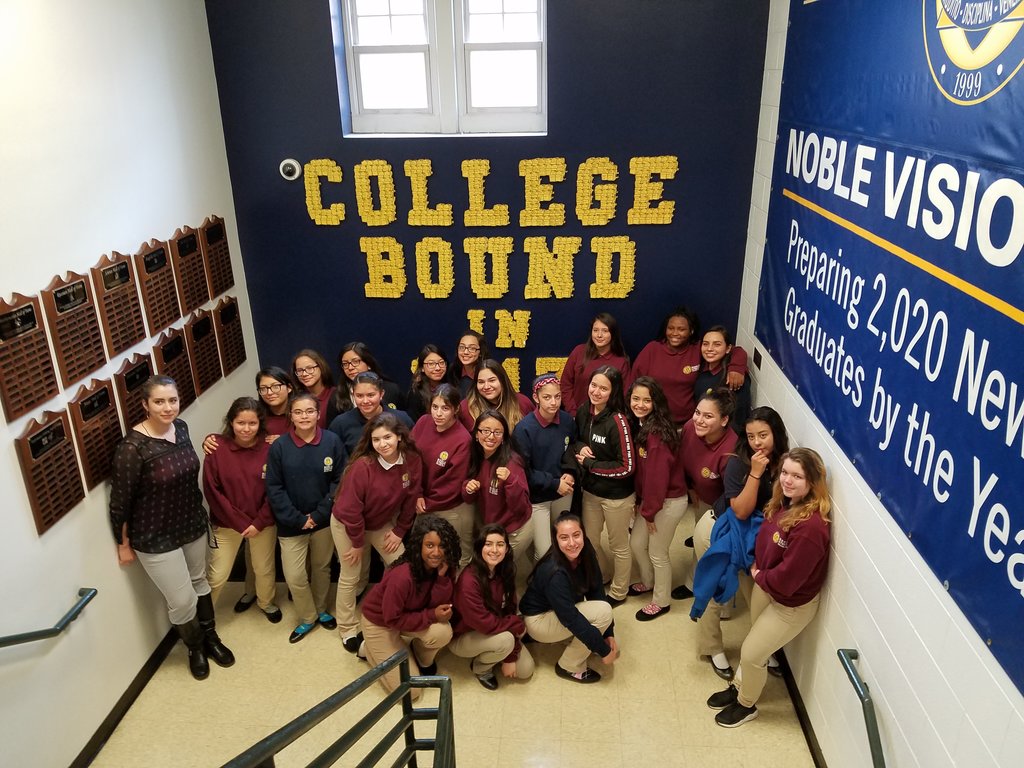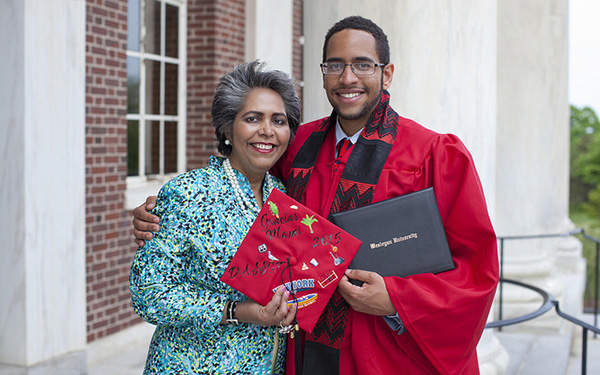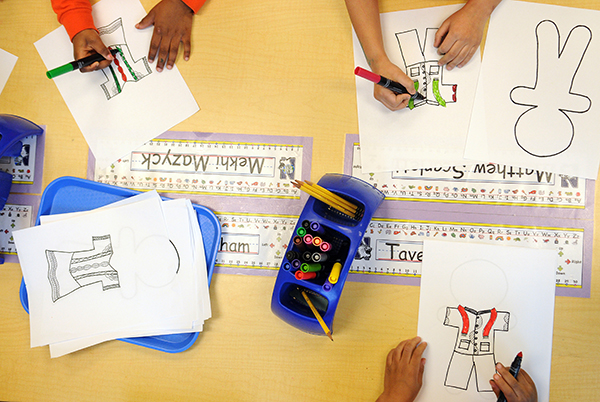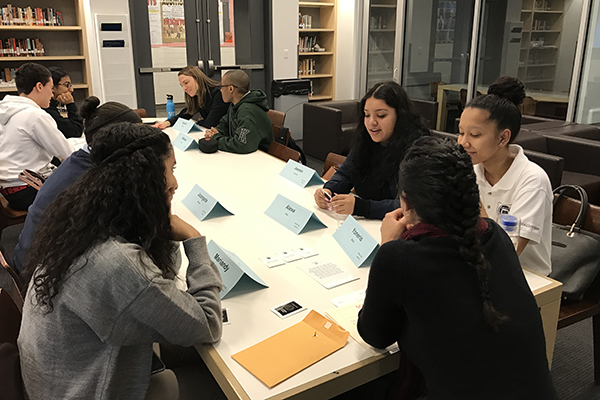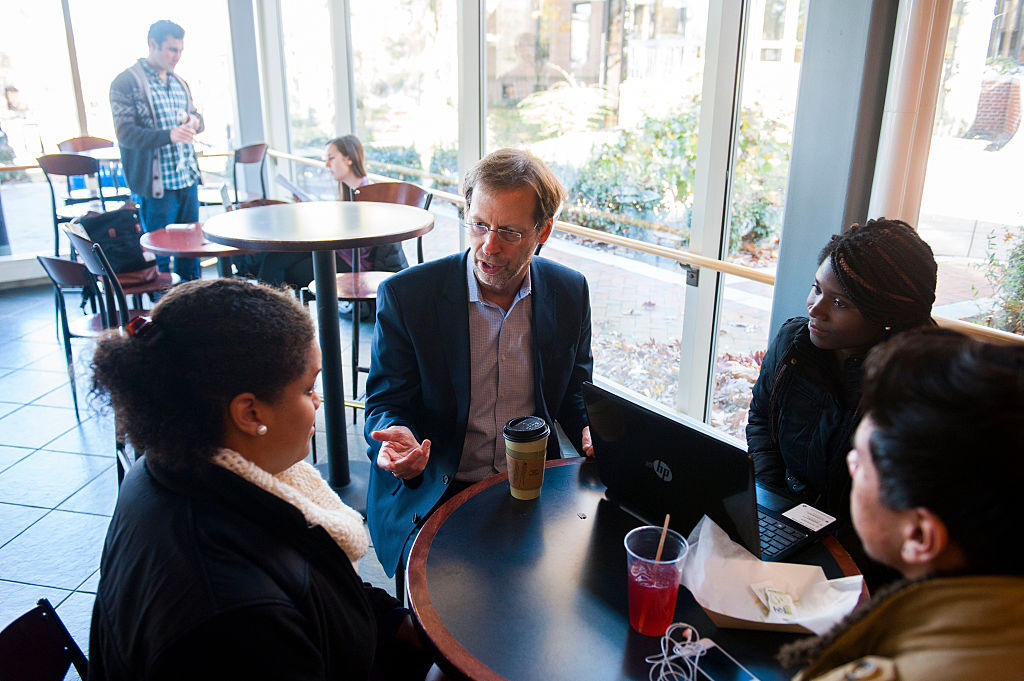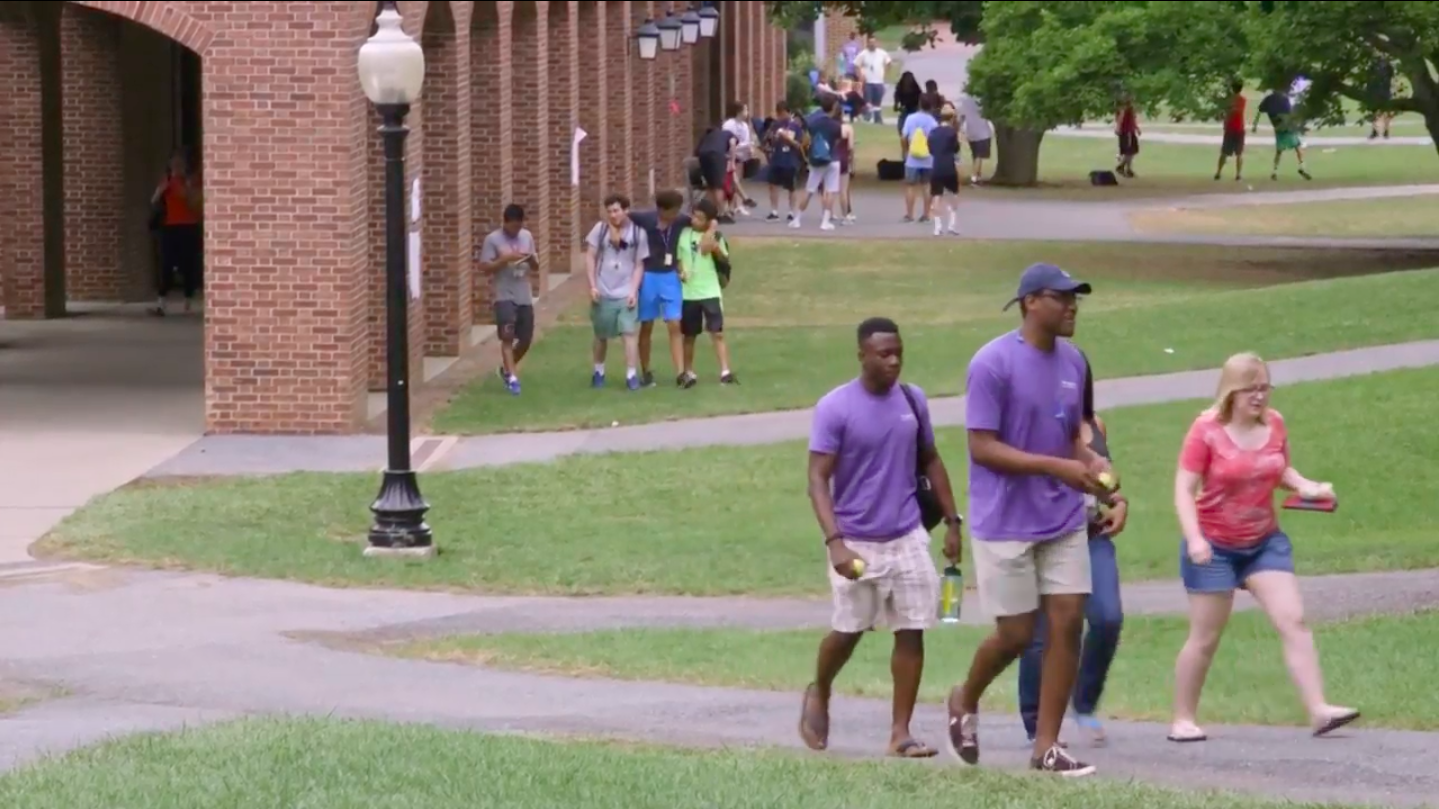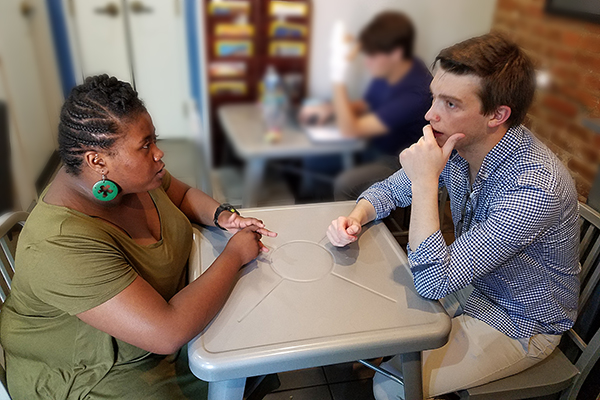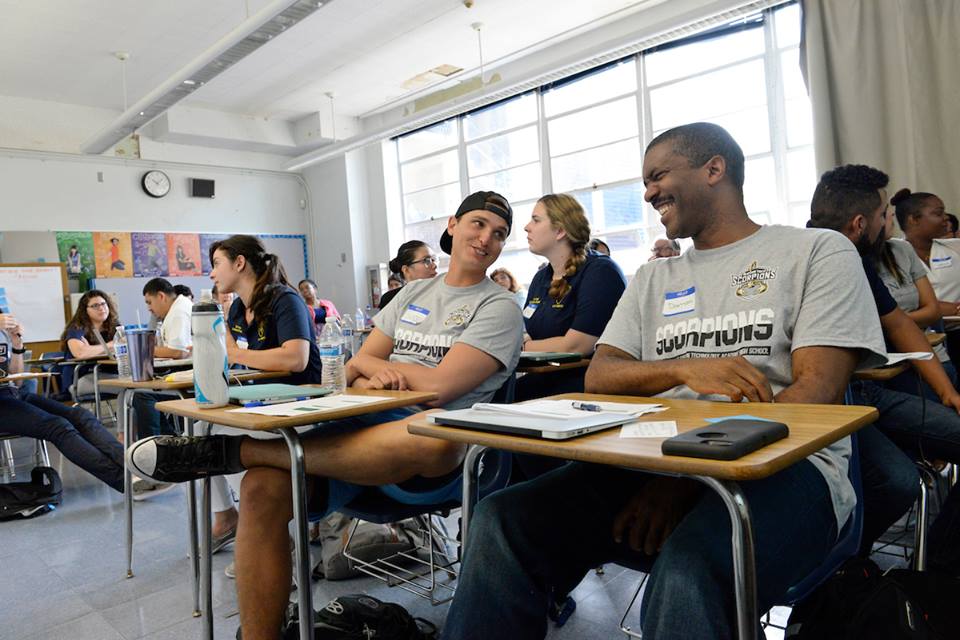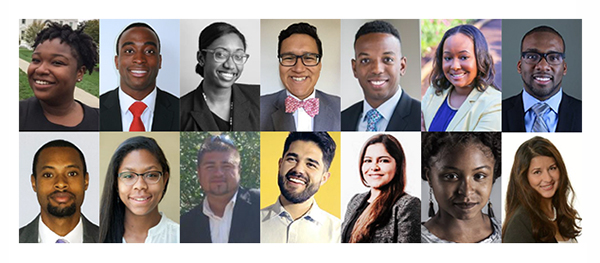KIPP NYC College Prep: Tracking Students Through College Like No One Else in America
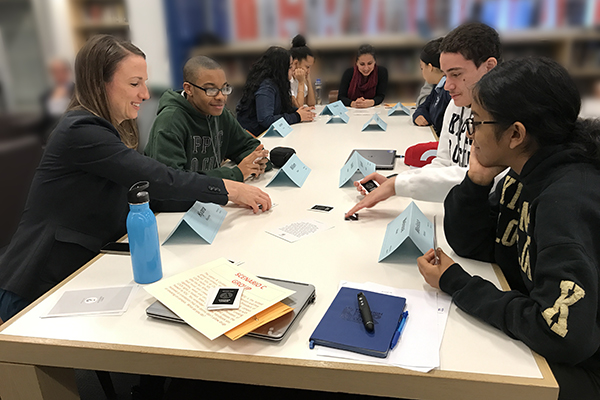
Students in a KIPP Through College Prep Class. (Photo credit: KIPP)
Nobody tracks their alumni into and through college like KIPP.
And that was strikingly clear the day I spent at KIPP NYC College Prep, a school that’s about half Hispanic, half black — and nearly all low-income.
Just a day at the school in New York City’s South Bronx explains how KIPP has made such rapid gains in its college success rate: In a college prep class for juniors, KIPP alumni from two different colleges came to tell the highs and lows of college life. A college prep session for seniors had several KIPP Through College counselors conducting role-playing sessions designed to guide the soon-to-be college students around danger areas. (Your friend steals a six-pack and jumps into a car with you to head to an off-campus party: What do you do?).
But, the day is far from over.
The school has a dozen counselors to track the New York alumni into and through college. I sat down with two KTC counselors, Becky Hamilton and Catherine Marciano, to learn how they use Salesforce software to track their students. Each student has a file loaded with every KIPP academic record since eighth grade: Grades for every semester, scores for every SAT taken, every college transcript (which students turn over in exchange for a book stipend), every tiny detail about financial aid — and every deadline for pretty much anything that needs an update. Every conversation with a student gets written up as a “contact note,” and is passed to a KTC supervisor for further scrutinizing the very same day.
HOW IT’S WORKING
The bottom line: 46 percent of the graduates at this New York school will earn bachelor’s degrees within six years, compared to 9 percent of students from families that make up the bottom fourth of earners. (Nationally, 38 percent of KIPP students achieve that success rate.)
Also striking about the diploma earning rate: KIPP insists on starting the “clock” on college graduation rates at the end of eighth grade (beginning of ninth grade for students new to the KIPP network), thus picking up any dropouts. So what’s the KIPP success rate that would match other charter networks that start their head counts in 12th grade? Impossible to say — but significantly higher.
The KTC program here is not cheap. KIPP spends roughly $2,000 per student per year on the program that will follow them into college, a figure that includes not just the seniors at the high school here, but the KIPP middle school alumni who went to a non-KIPP high school. In the coming years, as the KIPP alumni population grows, the plan is to reduce that to $1,600 per student.
A DECLARATION OF WAR
Tessa Kratz, director of college and career counseling at the high school, holds a pivotal role, akin to the lesser-known catcher on a World Series baseball team who directs the team to victory. She’s the one who makes sure students make it to the perfect-match college, which then the KTC counselors track them through.
In trying to boost college degree-earning, the counselors at KIPP NYC College Prep embrace two maxims. First, students should always “overmatch” colleges, meaning go to a college that’s a reach for them, mostly because better colleges take better care of students from places like the South Bronx. Second, whenever possible, students should try to win a spot in the Educational Opportunity Program (called Higher Education Opportunity Program at private universities).
Middle-class parents have never heard of EOP, mostly because students have to come from high-poverty neighborhoods like the South Bronx to get admitted. Once admitted, however, their odds of winning a degree soar, thanks to the counseling, tutoring, financial aid (near-full ride), and multiple other supports.
But here’s the best part about EOP for students from schools like College Prep, the part that melds the two maxims here: EOP helps students with that college stretch that lands them in a more prestigious university from which they are more likely to graduate.
A not-entirely-hypothetical example: Let’s say Columbia University has a freshman admittance floor for regular admission of a 4.0 GPA and 1400 SAT. For HEOP students, a 3.6 GPA and 1250 SAT might get them in the door.
“They would never get admitted through regular admissions, but they can get admitted through HEOP,” Kratz said.
But the spots are both coveted and limited: Kratz said SUNY New Paltz had an estimated 4,000 applications for 40 spots, which makes her job even more challenging to land those limited spots for her KIPPsters.
Each university has its own, tightly held EOP cutoff linked to a first-come, first-served award system. Plus, every year the state funding shifts, so everything is a moving target. Knowing the timing and GPA/SAT cutoffs for each public and private university — and the moving target aid numbers — takes a computerized campaign strategy that would make the Pentagon war planners proud.
“If 50 to 60 percent of our kids are eligible financially for this program, then we’re going to do everything we can to get those 50 to 60 percent of our kids into one of them,” Kratz said.
This is a true declaration of war — but it means everything. Kratz says the graduation rate boost for EOP kids is hard to calculate, because it varies by college. But everyone agrees: It’s big.
“This is what my senior year team spends an inordinate amount of time on — the paperwork for opportunity scholarships,” Kratz said. “You have to document everything.”
Kratz’s campaign starts in a student’s junior year, when parents coming to report card night in late April, after taxes are due, are asked to bring in their tax forms. Those tax returns are the key to winning any financial aid, including opportunity status. None of this is easy. Most of the tax returns that show up that night are unsigned, so back they go for signatures. But eventually, Kratz’s team gets signed tax returns for every student — forms that get scanned into their system.
More work continues over the following months, and when the right day arrives for the right university for just the right students with just the right GPA and just the right SAT score, that EOP application gets submitted. First come, first served.
That’s just a tiny piece of what KIPP does. Compare that to a traditional public high school in New York where there’s perhaps one guidance counselor (not college adviser, just a basic guidance counselor) for every 300 kids or more. There isn’t a chance that that counselor is going to track what Kratz’s team tracks. And that is one of many reasons why KIPP’s college graduation rates are standouts compared to their peers.
SHOOTING FOR THE STARS
KIPP started out as a network of middle schools. Years later, it became clear that to catch these kids up to their peers from middle-class families they needed to expand to both elementary and high school. KIPPsters who graduate from a KIPP high school, compared to those who leave a KIPP middle school to attend other schools, are about 10 percent more likely to enter college.
KIPP NYC College Prep is wrapped into the KIPP Through College philosophy. It’s a big package, probably explaining why 46 percent of KIPP students here earn college degrees 10 years after completing eighth grade.
Still, at KIPP College Prep, where all the KIPP students will graduate from a KIPP high school, the team shoots for far higher than 46 percent. The expectation here: 75 percent will graduate from college — a rate nearly as high as the graduation rate for children of upper-income parents.
And based on the rapid gains in college graduation rates KIPP has posted in recent years, it seems entirely possible that they’ll make it.
Watching the elaborate wraparound services here raises a question that KIPP asks itself: Does KIPP coddle its kids? In past years, when KIPP faced the fact that its students were not sticking with college at the hoped-for rate, the answer came back as a “yes.” Thus the famous KIPP pursuit of “grit,” infusing students with the self-advocacy skills considered necessary to survive in large college lecture classrooms where no KIPP-like teachers are hovering to shower students with the nudges needed to persevere.
Can the same criticism be applied to KIPP Through College? That exact question was raised during my visit by a junior listening to two KIPP alumni, Ashley Gutierrez from Brooklyn College and Sarina Vazquez from Hunter College, visiting a college prep class.
“Does KIPP hold your hand too much, and does that hurt you in college?” a male student asked.
Both alumni seemed surprised by the question, especially Gutierrez, who originally enrolled in SUNY Brockport in upstate New York and ran into severe academic problems — some of which she attributed to being so far away from her family in a rural environment where the social life revolved around having a car. Not only did she transfer out, but she also downsized her career goal from becoming an anesthesiologist to becoming a nurse.
This is what happens when you mess up, Gutierrez told the juniors, who appeared to hang on to every word of what became a confessional. KIPP Through College is what kept her college dreams alive, she told them. Her new goal: become a nurse anesthetist.
And all the college advice passed along in high school wasn’t just hand-holding, Vazquez told the juniors.
“KIPP is just letting you know what the real world is like,” she said.
Both alumni showered the juniors with advice: Get to know at least one professor. Avoid social isolation by forcing yourself to make new friends. Watch your GPA, or you can lose financial aid. Prepare yourself for long lab hours in science classes and lots of homework. Join a club.
Gutierrez advised them to take their current junior-year classes seriously. The more math and science absorbed in high school, the easier those college science classes will be.
“It’s OK to have fun in college, but school comes first,” she said.
The alumni passed along one piece of advice that would be rare to come from middle-class college students: Expect to feel extra pressure as a role model for being the first family member to attend college, and also a role model for the KIPPsters still in high school.
“It can get overwhelming, but you have to realize you are inspiration for those who come behind you,” Gutierrez said.
A similar message was raised repeatedly in the college prep class for seniors earlier in the day. When upper-middle-class students get in trouble, they can often count on parents to dig deeper into the family savings and land them at another college.
For the students leaving KIPP College Prep to enter college, there is no backup system. If you screw up and lose your financial aid package, there’s little even the elaborate support network that is KIPP Through College can do to bail you out.
“We’ve got your back, but we’re not heroes. If you get kicked out, it’s going to be very hard to get you back in,” one KTC counselor told the roomful of seniors, ticking off the list of loans and scholarships that keep their students afloat in college. “We don’t have the luxury of just moving you to another college.”
That chilling message punctuated the need to absorb the play-acting lessons of the day: how not to give in to peer pressure; what plagiarism is and isn’t; don’t assume if you are at another campus that the rules of your college don’t apply; know that when you sign a several-hundred-page student handbook, you will be held to what’s in it.
Also: Know the precise meaning of “no means no” sex guidelines: “It doesn’t matter what stage you’re in. As soon as someone says no, you have to put your clothes back on,” the counselors said.
And yet another lesson probably not told to upper-middle-class students: Get to know your advisers and understand that going to them to report problems is not “snitching.” Snitching has its roots in the criminal world, with one criminal vowing never to turn in another, one KTC counselor explained.
“Snitching is something between criminals,” he said. “You guys are not criminals.”
At the end of my day there, it was exhausting just to watch the process. But put it all together, and you understand KIPP’s fast-rising college success rates. A lot went into that national effort: more KIPP high schools, more KTC supports, wiser college matching, more college advising for high school juniors and seniors — pretty much more of everything.
Your Alumni
Story Here
We Recommend
-
Noble Network of Charter Schools: It’s Not Just About Going to College, It’s Also About Leaving to Learn Outside Chicago
-
King & Peiser: College Completion — Charter Schools as Laboratories
-
Q&A With UNCF CEO Michael Lomax: We’ve Got to Garner More Resources for Low-Income Kids for This Journey “To and Through” College
-
Gilchrist: My Charter School Saved My Life
-
Exclusive: Data Show Charter School Students Graduating From College at Three to Five Times National Average
-
WATCH: At Newark’s North Star Academy, 100% of the Class of 2017 Is Going to College
-
WATCH – The Alumni Tell Their Stories: College Gave Jadah Quick Upward Mobility
-
The Data Behind The Alumni: Unbundling Facts, Figures, and Caveats


